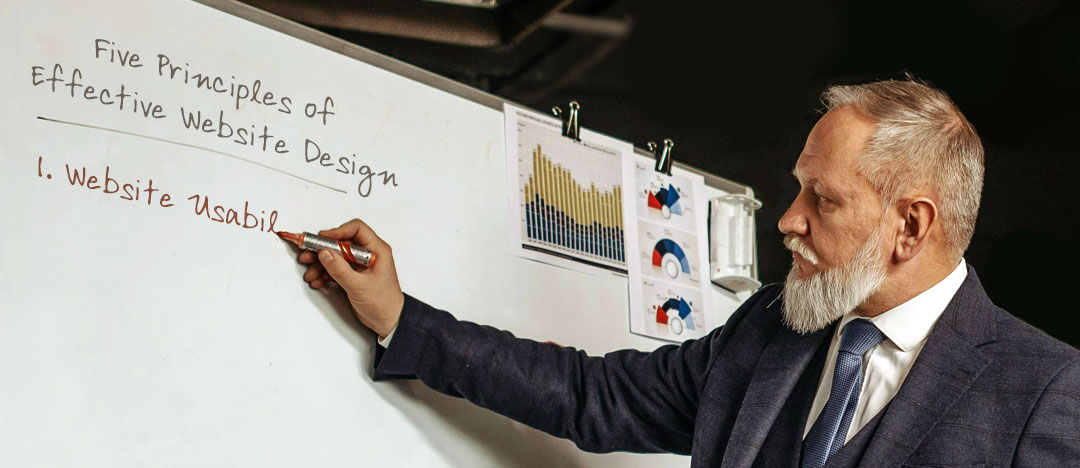Five Principles of Effective Website Design

A company’s website serves as more than just an online presence; it’s often the first and most critical touchpoint for potential customers. This is why a well-designed website is crucial for any business trying to establish a strong online presence and effectively engage with new customers.
Designing a website is a multifaceted endeavor that requires careful consideration of several fundamental principles. These principles serve as the guiding framework for creating websites that are not only visually appealing but also functional, user-friendly, and effective in achieving their intended goals. Here are five essential principles that guide the creation of impactful websites:
1. Website Usability
Usability is perhaps the most critical principle of web design as it directly impacts how users interact with and perceive your website’s value. Various techniques can help make your website more usable, such as:
User-Centered Design
A User-Centered Design (UCD) approach puts the user at the center of the design
process by prioritizing a website user’s needs, preferences, and behaviors. This methodology involves market research and feedback mechanisms such as surveys, interviews, and usability testing to comprehend user goals and pain points. By placing users at the center of the design process, companies can enhance satisfaction, increase engagement, and drive conversions by identifying usability issues, areas for improvement, and optimization.
Responsive Design
Responsive Design ensures websites adapt seamlessly to various devices and screen sizes, improving accessibility and user experience across various platforms (desktops, tablets, smartphones). This not only broadens audience reach but also boosts overall user satisfaction, engagement, and SEO rankings.
Clear Information Architecture
Clear and intuitive information architecture (a.k.a. navigational structure) is essential for guiding users through the website efficiently. Utilizing logical menu structures, intuitive labels, breadcrumbs, and search functionalities enhances usability and ensures users can find information quickly. A well-structured navigation system reduces bounce rates, improves time on site, and encourages exploration of content.
2. Simple Website Design
As Leonardo da Vinci famously said, "Simplicity is the ultimate sophistication." This principle holds true in web design. A simple and clean design reduces the cognitive load on users and is viewed as more aesthetically pleasing because it focuses on essential elements without unnecessary distractions. Keeping these points in mind will help you design a sophisticatedly simple website.
White Space
Complex designs with cluttered layouts can overwhelm users and lead to frustration. Minimalist design methods with ample, but not too much white space can create a sense of elegance and sophistication. White space, also known as negative space, improves readability and gives content room to breathe. It helps prevent visual clutter and allows users to focus on key elements, guiding their attention to important content.
Typography Selection
Simple design also uses typography as a means of communication. Readable fonts and a limited number of typefaces help maintain visual harmony. Font sizes and weights used in headings, subheadings, and body text enhance readability, convey hierarchy, and emphasize key messages.
Color Scheme
Colors can be used strategically to highlight important elements, create contrast, and evoke emotional responses. A cohesive and minimal number of colors enhance readability and make the website easy on the eyes. Consistent color schemes that align with brand identity contribute to a cohesive design.
3. Website Page Hierarchy and Organization
Two important aspects of a website page are its visual hierarchy and content organization. Visual hierarchy refers to the arrangement and prioritization of elements on a webpage that guides people through a page’s content. This is true for all types of content, including text, images, and video. It shows which content is most important, what to focus on first, and how the content is organized into sections or categories. Organizing content logically and hierarchically within a page ensures users can navigate a website’s page effortlessly and find relevant information quickly.
4. Consistency and Branding
Consistency in colors, typography, imagery, and design elements reinforces brand identity, and is another foundational principle in web design. Maintaining uniformity in design elements such as buttons, forms, icons, and headings throughout the website helps users interact with your site intuitively. Following established design patterns and functionality (e.g., placing the logo in the top-left corner or using a clickable logo to return to the homepage) enhances usability and familiarity.
5. Loading Speed and Performance
By prioritizing loading speed and performance, designers can minimize bounce rates, maximize user engagement, and improve SEO rankings.
Toenhance page speed, compress images and videos to improve performance. You could also minify CSS and JavaScript files by reducing HTTP requests. Limiting the number of elements (e.g., scripts, stylesheets) and combining files where possible reduces the time required for the browser to fetch resources. Implementing browser caching and server-side caching can also be helpful by reducing server load and speed up subsequent visits to the website.
Effective website design integrates these five principles to create a positive user experience that engages visitors, builds trust, and drives conversions. By continually evaluating and refining designs based on user feedback and technological advancements, you can ensure that your website will remain effective and aligned with your business objectives and evolving user expectations.
If your website is ready for a revamp or could better leverage the principles of website design to increase its performance, contact Paradigm today.
